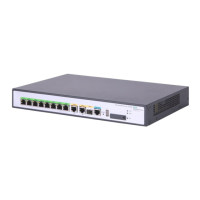297
Configuring MSTP
Only MSR20/30/50/93X/1000 routers support this feature.
As a Layer 2 management protocol, the Spanning Tree Protocol (STP) eliminates Layer 2 loops by
selectively blocking redundant links in a network, and allows for link redundancy.
Like many other protocols, STP evolves as the network grows. The later versions of STP are the Rapid
Spanning Tree Protocol (RSTP) and the Multiple Spanning Tree Protocol (MSTP). This chapter describes
the characteristics of STP, RSTP, and MSTP.
Introduction to STP
STP was developed based on the 802.1d standard of IEEE to eliminate loops at the data link layer in a
LAN. Devices running this protocol detect loops in the network by exchanging information with one
another and eliminate loops by selectively blocking certain ports to prune the loop structure into a
loop-free tree structure. This avoids proliferation and infinite cycling of packets that would occur in a loop
network and prevents decreased performance of network devices caused by duplicate packets received.
In the narrow sense, STP refers to the IEEE 802.1d STP. In the broad sense, STP refers to the IEEE 802.1d
STP and various improved spanning tree protocols derived from that protocol.
STP protocol packets
STP uses bridge protocol data units (BPDUs), also known as configuration messages, as its protocol
packets.
STP-enabled network devices exchange BPDUs to establish a spanning tree. BPDUs contain sufficient
information for the network devices to complete spanning tree calculation.
In STP, BPDUs have the following types:
• Configuration BPDUs—Used for calculating a spanning tree and maintaining the spanning tree
topology.
• Topology change notification (TCN) BPDUs—Used for notifying the concerned devices of network
topology changes, if any.
Basic concepts in STP
Root bridge
A tree network must have a root bridge.
There is only one root bridge in the entire network. The root bridge is not fixed, but can change along
with changes of the network topology.
When a network is initialized, each device generates and sends out BPDUs periodically with itself as the
root bridge. After network convergence, only the root bridge generates and sends out configuration
BPDUs at a certain interval, and the other devices just forward BPDUs.

